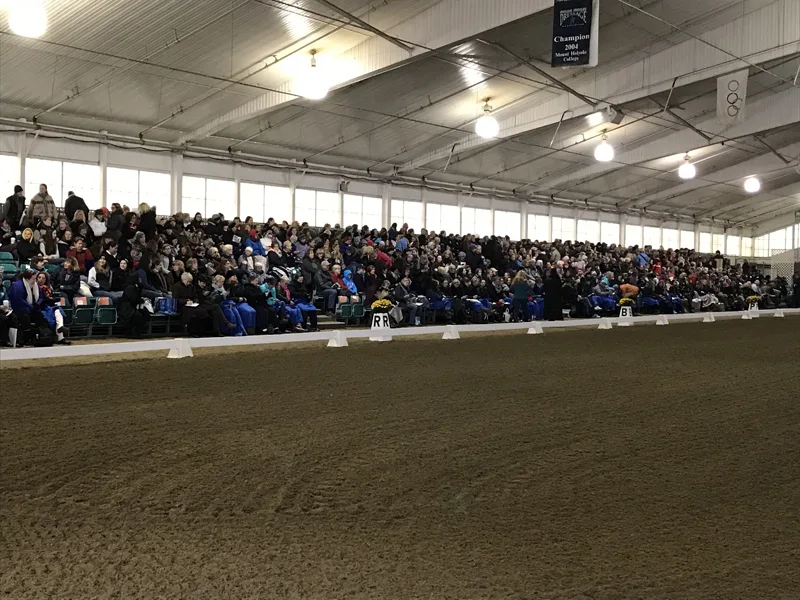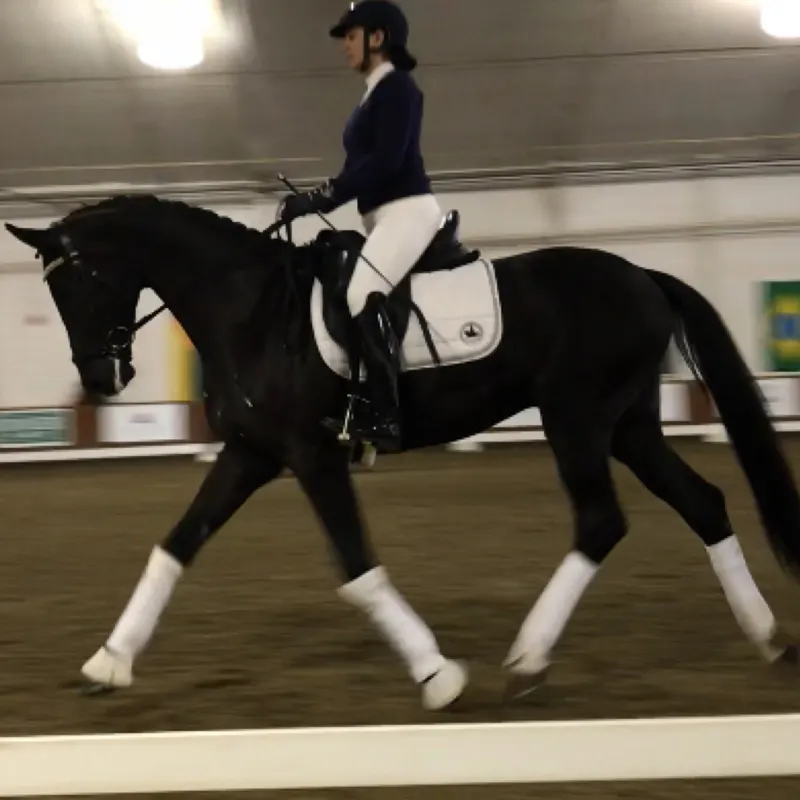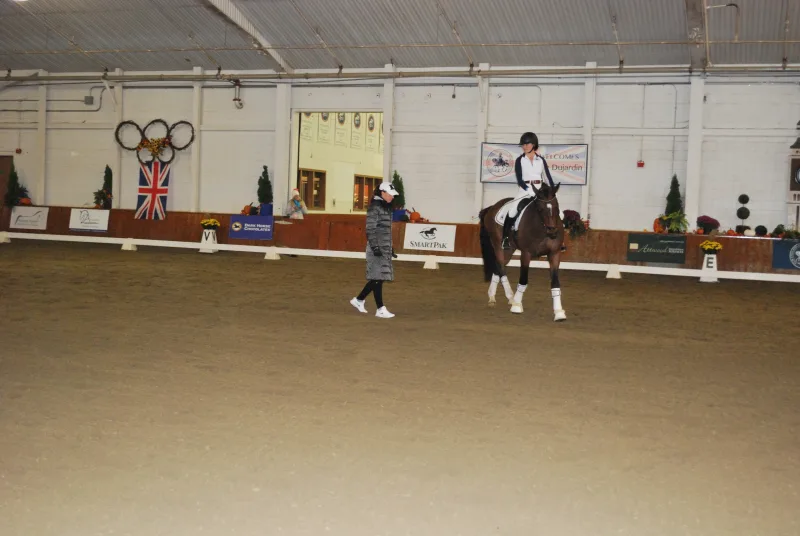While it was a cold and dreary weekend at New England Dressage Association’s fall symposium, the reception for Charlotte Dujardin was warm indeed! This marked Dujardin’s maiden voyage to New England, and she was loving every minute of it. “I AM FREEZING,” she declared, shivering, and mentioned she had to borrow a giant parka to keep from getting frostbite.
The spacious indoor at the Mount Holyoke College Equestrian Center, in Hadley, Massachusetts, was filled to capacity, holding over 900 eager spectators (most of whom were wrapped in blankets and geared up in snowsuits, which was a wise choice). Over the course of Oct. 13-14 we were lucky enough to experience a little slice of the drive, energy and endless attention to detail that has brought Dujardin to the top of her sport. We were treated to a wide range of horses from 4-year-olds to horses confident in the Grand Prix.
Regardless of the level, the underlying theme was strict attention to the little details. Dujardin pushed each rider to be their best and ride for that elusive 10. While her standards were high, Dujardin peppered the sessions with humor and wit.
We received a tremendous wealth of knowledge over the weekend, so in order not to overwhelm the readers with an absurd number of words, this recap will stick to our younger horse sessions. (With the full FEI report to soon follow!)
Each day began with the young horses, an impressive group of 4- and 5-year-old kids who handled the pressure and large crowd with grace.
Dujardin stressed the need for safety on young horses, especially in situations when the horse thinks that 900 spectators are about to eat him. “It can be hard to come right out and give the horse a good stretch when the rider is hanging on for dear life,” she said. “You always want to get there. You want him to be relaxed and to always have a good experience. But you cannot get there until you are certain you’re safe!”
Ashley Madison and Denali had a fluid ride, showing pleasant and relaxed work. “How long to work the 4-year-old is a question I often get,” said Dujardin. “This horse has come in, been good, done everything asked of him in 20 minutes. That is enough.”
Dujardin asked for correctly ridden transitions, and she was quick to take the riders to task for sloppy riding. This theme would be heard on repeat many times throughout the day. Even the 4-year-olds were asked to make the most correct, prompt and fluid transitions that they could.
“It is better to teach them the right way while they are young,” Dujardin stressed.
Cara Klothe’s mount Shurreal was another fine example of a correctly developed young horse. Noting the established quality of the basics, Dujardin encouraged Klothe to ride her more uphill.
“I’m certainly not looking for an FEI frame, but try to push the power from the hind legs into more uphill balance,” Dujardin said.
Multiple transitions led to improved balance, and the uphill results were quite apparent. “This horse has probably grown recently,” Dujardin said, “and when that happens it can take them a little while to recover their balance.”
“I’m so pleased that Charlotte pushed me to improve my horse’s frame,” Klothe said. “It can be easy to get into a comfort zone, and this horse really found a new gear today once I became comfortable asking for more!”
Dujardin gave Louisa Marcelle Eadie some advice to get her 5-year-old My Metall Waverley, whom she deemed “spicy,” to use his energy more positively. When the horse balked at the crowd Dujardin encouraged Eadie to “give him a jolly good Pony Club kick and have a YEE HAW!!”
ADVERTISEMENT
This prompted a chuckle from the crowd, as a “yee haw” is exactly what one might expect: a good, vigorous hand gallop. Yeeeee hawwww! Yee haw behind them, they went on to have a lovely workout (proving that “yee haw” is a quality training strategy).
“Sometimes the rider really needs to spell things out for the horse, make it completely black and white,” Dujardin advised. “They can make bad choices, but when they do, they must learn to go forward regardless of how they might feel.”
Dujardin encouraged Eadie to ride boldly and not be afraid to allow a movement to fall apart if the horse needs a redirection. “Always traveling forward can get messy but will always make things better,” she said. “Don’t worry about looking perfect. Explain to the horse what you want even if it means an occasional big kick.”
The lesson to go more forward continued when Amanda Gervais took center stage. The lovely Erdstern was immediately given a “time penalty” from Dujardin, as he casually trotted around. “Kick him, Amanda! Use what’s in those boots! Don’t be boring!” she encouraged.
Dujardin said 5-year-olds need to develop balance and obedience, to go both boldly forward and to accept the reins at the same time. “As you ride forward, try to massage the bit and imagine you have arms made of elastic,” was her suggestion, as Gervais worked towards more confident, uphill balance. “Get him to soften to you as you ride with power, rather than letting him talk you into giving up the reins.”
The crowd murmured with appreciation as horse and rider grew more confident, and the gaits became more exciting. The increased power of the gaits and suppleness to the bridle was apparent. “It’s about repeating what you want until the horse gets it right,” said Dujardin. “That’s dressage; it happens because you work, not because you hope.” (Author’s note: bummer…)
Both riders worked on developing improved response from their horses, requiring a quick reaction to the leg. Dujardin noted that while a whip can be helpful in many training situations, it is the leg to which the horse must react.
“I have riders who come out of the championship class at horse shows,” she said. “They are red and dripping sweat, and their horse looks quite rested and pleased! If you always use a whip to make the horse go, that will not change at the show.”
She also stressed basics over tricks. “Everyone is in a hurry to move up, to get to the next level, to do the fun stuff!” she said. “But can your horse bend? Go in rhythm? I would rather see a horse do correct transitions all day than to show a few tricks.”
Watching the young horses brought up the topic of what Dujardin looks for when choosing prospective mounts. She stressed that character trumps all, because while you can change gaits, it can be more troublesome, if not impossible, to change disposition. She looks for three clean, active gaits that show ground cover and natural balance. “I really don’t want a walk for a 10 as in the end it’s so difficult to collect,” she said. “I want to see the horse walk for a 7.5; that’s good enough for me. But I want a ’10’ disposition.”
The rider for the 6-year-old class was Eleni Econopouly aboard Filharmonic. Speaking about warm-up, Dujardin said she likes to get right to the canter. “Unless the horse is quite upset about something, I like to have a good walk, just a bit of trot, and then work on the canter immediately. I always have the feeling that the trot work is better after a good canter!”
The focus for this horse was to create more jump and activity in the canter, while avoiding the need for speed, and to improve his suppleness and elasticity. After several repetitions of travers to renvers in canter, much progress had been made. The increase in suppleness presented an opportunity to ask some collection questions.
“Think walk with your hands and canter with your legs,” was Dujardin’s advice on how to increase power while maintaining tempo and sanity. “Also, remember to use the reins elastically; move the bit in his mouth without moving your whole arm.”
The improvement in Filharmonic’s engagement and balance was noticeable and even better after more emphasis was placed on small efforts in travers. “When a horse is a bit short in his body, lots and lots of lateral work must be done to create suppleness,” explained Dujardin. “You cannot travel up and down your long side all day and expect the horse to become more pliable.”
ADVERTISEMENT
The hard work on Day 1 paid off tremendously for Filharmonic, and he was able to show off on the second day. “Well, this looks like a horse I would like to ride!” complimented Dujardin.
Details in the work were once again front and center, as Dujardin encouraged Econopouly to ride each movement precisely and to use the corners with authority. “The corners are a free space,” Dujardin instructed, “and if you don’t use them in correct bend and correct balance you are wasting a wonderful chance to prepare for what’s to come.”
When Filharmonic exhibited some tension in transitions from canter to walk, Dujardin encouraged the movement to be done in a leg-yield to keep the horse’s hind legs stepping. Filharmonic then tried to take this opportunity to show off some piaffe because he was clearly a bit of a ham.
“Well that’s nice to see,” quipped Dujardin, “but don’t let him use that against you!” Keeping his focus on stepping more sideways, rather than becoming short and close in the hind legs resulted in excellent cooperation (and definite piaffe reduction).
After her session Econopouly said, “I was so thankful to have Charlotte remind me to ride with more precision today. It can be easy to ride a movement for half a long side and then think you’ve done enough. It was very helpful to have her challenge me to do more and expect more and ride out of my comfort zone. Her suggestion to use the rein in a more elastic was very useful as well. I could immediately feel the way it helped to change my horse’s suppleness and use of his body.”
Wrapping up both mornings was Micaela Mabragana on the positively gorgeous third level mare Fleur. While polite, Fleur was clearly anxious about the crowd on Day 1. Some completely justifiable tightness led to a session full of calming lateral work and transitions.
Unlike some of the horses earlier in the day, this was one who needed the neck ridden slightly lower, rather than to be brought up. “She is so naturally uphill; that’s just where she is,” Dujardin said. “That will be lovely later on, but for today we can make her more elastic, supple and willing by riding her neck just a bit lower.”
Fleur was the first mare in the ring, and an audience member asked about gender preference in dressage horses. “It’s so personal,” said Dujardin. “I have probably seven mares currently, whom I adore, and I have had and do have many geldings. I’m not the biggest stallion fan, as their minds seem to be on another job altogether, but clearly there are many wonderful dressage stallions.”
Sunday brought a great increase of relaxation for Fleur, and we were treated to some exceptional trot work. Showing fluid half-passes Dujardin commented, “Mica is clearly an experienced rider; she is demonstrating the exact set-up, bend and quality of gait required to do this work.”
The canter work focused on strategy to develop flying changes in a young horse, especially one so bold. Using a 10-meter figure-eight, the change was positioned towards “C” in order to use the wall as an emergency break. “There are many good reasons to do changes this way,” advised Dujardin. “With this horse, her canter is already so large that the wall will help to gather her up, without the rider needing to use much rein. With a horse a bit lazier, it gives the rider the option to really ride forward but still be able to effectively balance the change.”
Fleur showed positively ginormous changes, making it clear to all how effective this exercise was.
It was exciting watching the young horses work and seeing the progression up the levels and within each training session. Riders were repeatedly reminded to ride correctly, every step of the way.
A sloppy transition might get a “well…. just dreadful!” from Dujardin, who is clearly a student of Carl Hester in the dry British humor department, but good moments brought plenty of praise. “Was that good enough?” was a question frequently asked to each rider throughout the weekend. For all of us wishing to develop our skills, it was such an important reminder to always strive for more, and better!
Cliffhanger time: What is to come? More YEE HAW?? Perhaps, but definitely some fine examples of developing and established FEI horses. (And I will use the quote that has already become famous, as we shall all discover what it means to be deemed “A fairy on a Christmas tree.”)





















